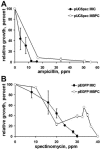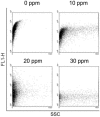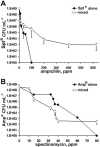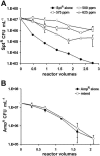Influences of biofilm structure and antibiotic resistance mechanisms on indirect pathogenicity in a model polymicrobial biofilm
- PMID: 16820500
- PMCID: PMC1489306
- DOI: 10.1128/AEM.02474-05
Influences of biofilm structure and antibiotic resistance mechanisms on indirect pathogenicity in a model polymicrobial biofilm
Abstract
Indirect pathogenicity (IP), the commensal protection of antibiotic-sensitive pathogens by resistant microorganisms of low intrinsic virulence, can prevent the eradication of polymicrobial infections. The contributions of antibiotic resistance mechanisms and biofilm structure to IP within polymicrobial biofilms were investigated using a model two-member consortium. Escherichia coli ATCC 33456 was transformed with vectors conferring either ampicillin or spectinomycin resistance, creating two distinct populations with different resistance mechanisms. Each strain alone or the consortium was grown as biofilms in flow cells and planktonically in chemostats. Comparisons in survival and activity were made on the basis of MICs and minimum biofilm preventative concentrations, a newly introduced descriptor. In ampicillin-containing medium, commensal interactions were evident during both modes of cultivation, but the sensitive strain experienced a greater benefit in the chemostat, indicating that the biofilm environment limited the commensal interaction between the Amp(r) and Spt(r) strains. In spectinomycin-containing medium, growth of the sensitive strain in chemostats and biofilms was not aided by the resistant strain. However, green fluorescent protein expression by the sensitive strain was greater in mixed-population biofilms (9% +/- 1%) than when the strain was grown alone (2% +/- 0%). No comparable benefit was evident during growth in the chemostat, indicating that the biofilm structure contributed to enhanced activity of the sensitive strain.
Figures








Similar articles
-
Enhanced high copy number plasmid maintenance and heterologous protein production in an Escherichia coli biofilm.Biotechnol Bioeng. 2007 Jun 15;97(3):439-46. doi: 10.1002/bit.21240. Biotechnol Bioeng. 2007. PMID: 17058286
-
Escherichia coli serotype O157:H7 retention on solid surfaces and peroxide resistance is enhanced by dual-strain biofilm formation.Foodborne Pathog Dis. 2010 Aug;7(8):935-43. doi: 10.1089/fpd.2009.0503. Foodborne Pathog Dis. 2010. PMID: 20367070
-
Effects of the twin-arginine translocase on the structure and antimicrobial susceptibility of Escherichia coli biofilms.Can J Microbiol. 2005 Aug;51(8):671-83. doi: 10.1139/w05-048. Can J Microbiol. 2005. PMID: 16234865
-
Biofilm-specific antibiotic resistance.Future Microbiol. 2012 Sep;7(9):1061-72. doi: 10.2217/fmb.12.76. Future Microbiol. 2012. PMID: 22953707 Review.
-
Biofilms and antibiotic therapy: is there a role for combating bacterial resistance by the use of novel drug delivery systems?Adv Drug Deliv Rev. 2005 Jul 29;57(10):1539-50. doi: 10.1016/j.addr.2005.04.007. Adv Drug Deliv Rev. 2005. PMID: 15950314 Review.
Cited by
-
The microbial community of the cystic fibrosis airway is disrupted in early life.PLoS One. 2014 Dec 19;9(12):e109798. doi: 10.1371/journal.pone.0109798. eCollection 2014. PLoS One. 2014. PMID: 25526264 Free PMC article.
-
Toward automated analysis of biofilm architecture: bias caused by extraneous confocal laser scanning microscopy images.Appl Environ Microbiol. 2007 Aug;73(15):4922-30. doi: 10.1128/AEM.00023-07. Epub 2007 Jun 1. Appl Environ Microbiol. 2007. PMID: 17545329 Free PMC article.
-
BacA: a possible regulator that contributes to the biofilm formation of Pseudomonas aeruginosa.Front Microbiol. 2024 Mar 5;15:1332448. doi: 10.3389/fmicb.2024.1332448. eCollection 2024. Front Microbiol. 2024. PMID: 38505547 Free PMC article.
-
Combining Biofilm-Controlling Compounds and Antibiotics as a Promising New Way to Control Biofilm Infections.Pharmaceuticals (Basel). 2010 May 11;3(5):1374-1393. doi: 10.3390/ph3051374. Pharmaceuticals (Basel). 2010. PMID: 27713308 Free PMC article. Review.
-
Developing selective media for quantification of multispecies biofilms following antibiotic treatment.PLoS One. 2017 Nov 9;12(11):e0187540. doi: 10.1371/journal.pone.0187540. eCollection 2017. PLoS One. 2017. PMID: 29121069 Free PMC article.
References
-
- Adair, C. G., S. P. Gorman, B. M. Feron, L. M. Byers, D. S. Jones, C. E. Goldsmith, J. E. Moore, J. R. Kerr, M. D. Curran, G. Hogg, C. H. Webb, G. J. McCarthy, and K. R. Milligan. 1999. Implications of endotracheal tube biofilm for ventilator-associated pneumonia. Intensive Care Med. 25:1072-1076. - PubMed
-
- Atlas, R. M., and R. Bartha. 1997. Microbial ecology: fundamentals and applications, 4th ed. Addison-Wesley Publishing Co., New York, N.Y.
-
- Brook, I. 1994. Indirect pathogenicity. Infect. Dis. Clin. Pract. 3:S21-S27.
-
- Brook, I. 2002. Microbiology of polymicrobial abscesses and implications for therapy. J. Antimicrob. Chemother. 50:805-810. - PubMed
Publication types
MeSH terms
Substances
LinkOut - more resources
Full Text Sources
Other Literature Sources
Medical

